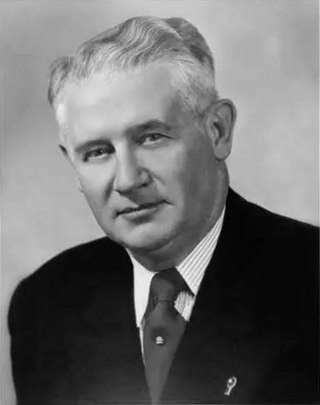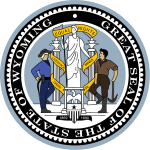
The 1934 United States Senate elections were held in the middle of Democratic President Franklin D. Roosevelt's first term. The 32 seats of Class 1 were contested in regular elections, and special elections were held to fill vacancies. During the Great Depression, voters strongly backed Roosevelt's New Deal and his allies in the Senate, with Democrats picking up a net of nine seats, giving them a supermajority. Republicans later lost three more seats due to mid-term vacancies, however, a Democratic in Iowa died and the seat remained vacant until the next election. Democrats' entered the next election with a 70-22-2-1 majority.

Joseph Christopher O'Mahoney was an American journalist, lawyer, and politician. A Democrat, he served four complete terms as a U.S. senator from Wyoming on two occasions, first from 1934 to 1953 and then again from 1954 to 1961.
The Wyoming Democratic Party is the affiliate of the Democratic Party in Wyoming, headquartered in Cheyenne. The party was strong during Wyoming's territorial days, but suffered a decline in its early statehood. It rose to prominence again from the 1930s to the 1950s before experiencing another decline.
The Wisconsin Progressive Party (1934–1946) was a political party that briefly held a dominant role in Wisconsin politics.

The 1960 United States Senate election in Wyoming was held on November 8, 1960. Incumbent Democratic Senator Joseph C. O'Mahoney was first appointed to the U.S. Senate from Wyoming's Class 1 Senate seat in 1934, and was re-elected in 1934, 1940, and 1946 before losing re-election in 1952. He was then elected to the Class 2 Senate seat in 1954. O'Mahoney, in failing health and increasingly limited in his mobility, declined to run for a fifth non-consecutive term in the Senate. The winner of this election, Keith Thomson, died before assuming his elected office.

The 1942 United States Senate election in Wyoming was held on November 3, 1942. Democratic Senator Harry Schwartz ran for re-election to his second term. He was challenged by businessman Edward V. Robertson, who emerged from a close and hotly contested Republican primary as the narrow winner. Aided in part by the national swing toward Republicans in 1942, Robertson defeated Schwartz for re-election by a decisive margin.

The 1958 United States Senate election in Wyoming took place November 4, 1958. Incumbent Republican Senator Frank A. Barrett ran for re-election to his second term. He was challenged by Gale W. McGee, a University of Wyoming professor and the Democratic nominee. Despite the state's strong Republican lean, McGee ran an energetic campaign against Barrett, earning the support of the national Democratic establishment. McGee ultimately narrowly upset Barrett, winning 51% of the vote to Barrett's 49%.

The 1952 United States Senate election in Wyoming took place November 4, 1952. Incumbent Democratic senator Joseph C. O'Mahoney ran for his fourth consecutive term. He faced a strong challenge from Republican governor Frank A. Barrett, and faced difficult headwinds as Dwight D. Eisenhower, the Republican nominee for president, was winning Wyoming in a landslide over Democratic nominee Adlai Stevenson. Despite his history of strong performances in the increasingly conservative state, however, O'Mahoney was unable to replicate it, and narrowly lost to Barrett. However, O'Mahoney would return to the Senate less than two years later; following the death of Senator Lester C. Hunt, he was elected to the Senate once again in the 1954 election.

The 1924 United States Senate election in Wyoming took place on November 4, 1924. Incumbent Republican Senator Francis E. Warren ran for re-election to his sixth consecutive term in the Senate. He was challenged by Judge Robert Rose of the Eighth Judicial District of Wyoming, the Democratic nominee. The election took place on the same ballot as the presidential election, with Republican Calvin Coolidge winning Wyoming by a wide margin, and the special gubernatorial election, with Democratic Nellie Tayloe Ross similarly winning by a wide margin. Both Warren and Rose outperformed their party's presidential nominees, and Warren ultimately won re-election by a wide margin, albeit reduced from 1918. This would be Warren's last term in the Senate; he died on November 24, 1929, with a little more than a year remaining in his term. Republican Patrick Joseph Sullivan was appointed to replace him.

The 1930 United States Senate election in Wyoming was held on November 4, 1930. Following the death of Republican Senator Francis E. Warren, former Casper Mayor Patrick J. Sullivan was appointed to replace him. Sullivan did not seek re-election, however. Following a contested Republican primary, former Governor Robert D. Carey emerged as the nominee, and faced Democrat Harry Schwartz, an attorney from Casper and a local school board member, in the general election. Despite the strong performance by Democrats nationwide in 1930, Carey defeated Schwartz by a wide margin.

The 1940 United States Senate election in Wyoming took place on November 5, 1940. Democratic Senator Joseph C. O'Mahoney ran for re-election to a second full term. He faced Republican Milward Simpson, a member of the University of Wyoming Board of Trustees and a former State Representative, in the general election. Though the presidential election in Wyoming was relatively close, O'Mahoney outperformed President Franklin D. Roosevelt's narrow win, and defeated Simpson in a landslide to win his second term.

The 1964 United States Senate election in Wyoming took place on November 3, 1964. Incumbent Democratic Senator Gale W. McGee ran for re-election to his second term. In the general election, he faced Republican nominee John S. Wold, the former Chairman of the Republican Party of Wyoming and a former State Representative. Despite Wyoming's long conservative streak, McGee was aided by the strong performance by President Lyndon B. Johnson in Wyoming. McGee ended up winning re-election by a relatively narrow, but decisive, margin, beating Wold 54-46%.

The 1970 Wyoming gubernatorial election took place on November 3, 1970. Incumbent Republican Governor Stanley Hathaway ran for re-election to a second term. He faced Democratic nominee John J. Rooney, a State Representative and the former Chairman of the Wyoming Democratic Party. Despite Democratic Senator Gale W. McGee's strong performance in the U.S. Senate race, Hathaway's popularity proved an insurmountable obstacle for Rooney to overcome, and the Governor won a second term in a landslide.

The 1946 Wyoming gubernatorial election took place on November 5, 1946. Incumbent Democratic Governor Lester C. Hunt ran for re-election to a second term. Former Republican Governor Nels H. Smith, whom Hunt defeated in 1942, announced that he would challenge Hunt for re-election, but he was defeated the Republican primary by State Treasurer Earl Wright. In the general election, even though the Republican Party had a strong performance nationwide, Wyoming Democrats did well; Hunt defeated Wright by a wider margin than his 1942 victory as Democratic U.S. Senator Joseph C. O'Mahoney similarly won another term.

The 1934 United States Senate elections in Wyoming took place on November 6, 1934. Incumbent Democratic Senator John B. Kendrick died on November 3, 1933, and Joseph C. O'Mahoney was appointed by Governor Leslie A. Miller as Kendrick's replacement. Two elections for the same Senate seat were held on the same day; one as a special election to fill the remainder of Kendrick's original six-year term, and another to select a Senator to serve the next six-year term. O'Mahoney ran for re-election in both elections. He was opposed by Republican Congressman Vincent Carter. Aided by the strong performance by the Democratic Party throughout the country in 1934, and by Governor Miller's landslide re-election, O'Mahoney handily defeated Carter to win re-election.

The 1954 United States Senate elections in Wyoming took place on November 2, 1954. Incumbent Democratic Senator Lester C. Hunt, who decided not to be a candidate for re-election, committed suicide by firearm on June 19, 1954, and Republican Governor Clifford J. Rogers appointed former state highway commissioner Edward D. Crippa to replace him. Two elections for the Senate seat were held on the same day; one as a special election to fill the remainder of Hunt's original six-year term, and another to select a Senator to serve the next six-year term. Senator Crippa did not run for re-election.

A general election was held in the U.S. state of Wyoming on Tuesday, November 5, 1946. All of the state's executive officers—the governor, secretary of state, auditor, treasurer, and superintendent of public instruction—were up for election. The election was largely a rout for the Republican Party. Though Democratic governor Lester C. Hunt was narrowly re-elected, Democrats lost their two other state offices: auditor and secretary of State. Moreover, they were unable to win back any other state offices.

A general election was held in the U.S. state of Wyoming on Tuesday, November 7, 1950. All of the state's executive officers—the governor, secretary of state, auditor, treasurer, and superintendent of public instruction—were up for election. The Republican Party swept all of the offices. Following Democratic governor Lester C. Hunt's election to the U.S. Senate in 1948, Republican secretary of state Arthur G. Crane had been acting as governor. Republican Congressman Frank A. Barrett was elected governor, and Republican candidates won the other statewide races.

A general election was held in the U.S. state of Wyoming on Tuesday, November 2, 1954. All of the state's executive officers—the governor, secretary of state, auditor, treasurer, and superintendent of public instruction—were up for election. The result was largely a continuation of Republican rule, though Democrat Velma Linford won the election for Superintendent and the margins in most of the other races shrunk considerably from 1950.

A general election was held in the U.S. state of Wyoming on Tuesday, November 5, 1918. All of the state's executive officers—the Governor, Secretary of State, Auditor, Treasurer, and Superintendent of Public Instruction—were up for election. Republicans won all statewide offices by wide margins, and with Robert D. Carey's defeat of Frank L. Houx, picked up the governorship following two consecutive losses to Democrats.








